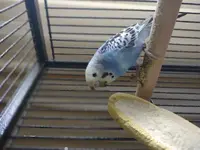I've had my budgie, Afina, for about six months now. She came from a pet store (I know, I know, it's not something I'm proud of). I'm not sure about her age. After adopting her, the pet store recommended a specific brand of food (ZuPreem Fruit Blend) as it's what they fed the birds in store.
Afina RARELY eats fresh fruit. I've tried many times to give her fresh fruit and seeds and she really only has an interest in her pellet food, millet, and treat sticks. Which does fine for her need for seeds, I suppose.
HOWEVER, through the last couple of months, I have noticed times when there seems to be some kind of goo on her feet and covering her forehead and beak. She will pick and eat this off of herself. I haven't actually witnessed her vomiting, but I can't imagine it being anything else as it does NOT resemble her feces at all.
She gets fresh water daily, fresh pellet food daily, a small piece of millet daily, and almost always has a treat stick in her cage (although I just began doing this, AFTER the vomiting).
WHAT IS GOING ON WITH MY BUDGIE BABY??!!
There aren't any local avian verts in my town, and I honestly cannot rely on Facebook groups to give me reliable info.
I LOVE my birdie, and I want her to be happy and healthy.
Any advice or past experiences?
Any suggestions to get my FiFi to enjoy some fresh fruit and berries?
Afina RARELY eats fresh fruit. I've tried many times to give her fresh fruit and seeds and she really only has an interest in her pellet food, millet, and treat sticks. Which does fine for her need for seeds, I suppose.
HOWEVER, through the last couple of months, I have noticed times when there seems to be some kind of goo on her feet and covering her forehead and beak. She will pick and eat this off of herself. I haven't actually witnessed her vomiting, but I can't imagine it being anything else as it does NOT resemble her feces at all.
She gets fresh water daily, fresh pellet food daily, a small piece of millet daily, and almost always has a treat stick in her cage (although I just began doing this, AFTER the vomiting).
WHAT IS GOING ON WITH MY BUDGIE BABY??!!
There aren't any local avian verts in my town, and I honestly cannot rely on Facebook groups to give me reliable info.
I LOVE my birdie, and I want her to be happy and healthy.
Any advice or past experiences?
Any suggestions to get my FiFi to enjoy some fresh fruit and berries?


